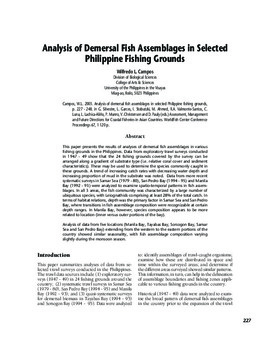Analysis of demersal fish assemblages in selected Philippine fishing grounds

Citation
Campos, W.L. (2003). Analysis of demersal fish assemblages in selected Philippine fishing grounds. p. 227-248. Assessment, management and future directions for coastal fisheries in Asian countries. WorldFish Center conference proceedings; 67
This paper presents the results of analyses of demersal fish assemblages in various fishing grounds in the Philippines. Data from exploratory trawl surveys conducted in 1947 - 49 show that the 24 fishing grounds covered by the survey can be arranged along a gradient of substrate type (i.e. relative coral cover and sediment characteristics). These may be used to determine the species commonly caught in these grounds. A trend of increasing catch rates with decreasing water depth and increasing proportion of mud in the substrate was noted. Data from more recent systematic surveys in Samar Sea (1979 - 80), San Pedro Bay (1994 - 95) and Manila Bay (1992 - 93) were analyzed to examine spatio-temporal patterns in fish assemblages. In all 3 areas, the fish community was characterized by a large number of ubiquitous species, with Leiognathids comprising at least 28% of the total catch. In terms of habitat relations, depth was the primary factor in Samar Sea and San Pedro Bay, where transitions in fish assemblage composition were recognizable at certain depth ranges. In Manila Bay, however, species composition appears to be more related to location (inner versus outer portions of the bay). Analysis of data from five locations (Manila Bay, Tayabas Bay, Sorsogon Bay, Samar Sea and San Pedro Bay) extending from the western to the eastern portions of the country showed similar seasonality, with fish assemblage composition varying slightly during the monsoon season.
Permalink
Date Available
Type
Publisher
Countries
Copyright
CC BY 4.0
Research Themes
Language